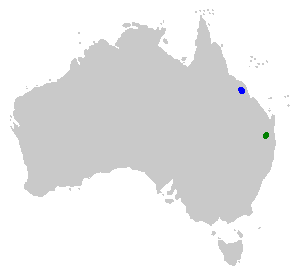Northern gastric-brooding frog facts for kids
Quick facts for kids Northern gastric-brooding frog |
|
|---|---|
| Conservation status | |
| Scientific classification |
The Rheobatrachus vitellinus, also known as the northern gastric-brooding frog, was a very special frog from Australia. It was famous for a unique way of raising its young: the mother would swallow her eggs and keep the tadpoles safe inside her stomach until they were ready to hop out as tiny frogs! Sadly, this amazing frog is now extinct, meaning it has completely disappeared from Earth.
Contents
Where Did This Amazing Frog Live?
The northern gastric-brooding frog was first discovered in 1984 by a scientist named Michael Mahony. It lived only in a small part of Queensland, Australia. This area included the rainforests of the Clarke Range in Eungella National Park and Pelion State Forest.
This frog's home was quite small, less than 500 square kilometers (about 193 square miles). It preferred living at higher places, between 400 and 1000 meters (about 1,300 to 3,300 feet) above sea level. Sadly, just one year after it was found, no one ever saw this frog again. Even with many searches, it could not be found, and so it is now considered extinct.
What Did This Frog Look Like?
The northern gastric-brooding frog was bigger than its cousin, the southern gastric-brooding frog. Male frogs grew to be about 50 to 53 millimeters (2 to 2.1 inches) long. Female frogs were even larger, reaching 66 to 79 millimeters (2.6 to 3.1 inches) in length.
This frog was usually a pale brown color. Like other gastric-brooding frogs, its skin felt bumpy and had a slimy coating. A cool feature was the bright yellow patches on its belly and the underside of its arms and legs. The rest of its belly was white or grey. Its eyes had a dark brown iris, and its eardrum (tympanum) was hidden. Its body shape was very similar to the southern gastric-brooding frog.
Its Home and Habits
The northern gastric-brooding frog lived only in very clean rainforests. These areas had very little human disturbance, maybe just a few walking paths. Like its southern relative, this frog loved water. It spent most of its time in and around shallow, fast-flowing creeks and streams.
You could find these frogs hiding in rocky areas, near small waterfalls, or in calm spots behind rocks. The water in these streams was always cool and clear. They would hide under or between boulders in the current or in quiet pools.
What Did It Eat?
Scientists observed that the northern gastric-brooding frog ate different kinds of insects. Its diet included caddisfly larvae, which are insect young that live in water. It also ate beetles that lived on land and in the water. Interestingly, it was also seen eating the Eungella torrent frog (Taudactylus eungellensis).
Can We Bring It Back?
Scientists are working hard to try and bring the gastric-brooding frog species back to life. They are using a special method called somatic-cell nuclear transfer (SCNT), which is a type of cloning.
In March 2013, Australian scientists had an exciting breakthrough. They successfully created a living embryo from genetic material that had been preserved. These scientists are from the University of Newcastle Australia. The team includes Professor Michael Mahony, who first discovered the northern gastric-brooding frog, along with Simon Clulow and Professor Mike Archer from the University of New South Wales.
They hope to keep using SCNT to create an embryo that can grow into a tadpole. Professor Mike Archer said, "We do expect to get this guy hopping again." The scientists have also managed to successfully freeze and thaw amphibian embryonic cells. This shows that it's possible to store genetic material for threatened amphibians and other animals, like a special bank for their genes.



